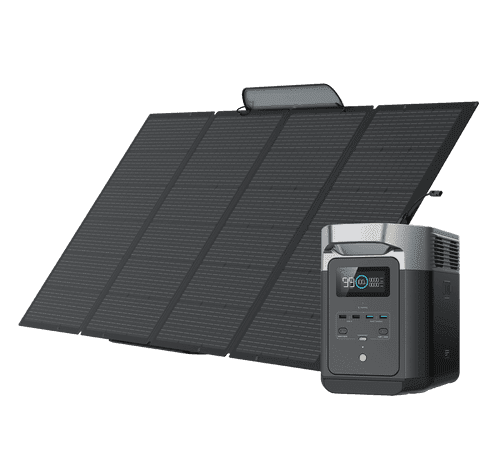The lights flicker, then darkness descends. Your point-of-sale system goes black, computers shut down, and that crucial client presentation grinds to a halt. In today’s digital economy, power outages aren’t just inconvenient—they’re potentially devastating for small businesses.
Each year, power disruptions cost American small businesses a staggering $150 billion in lost productivity, spoiled inventory, and missed opportunities. From retail stores unable to process transactions to professional services firms losing critical data, even brief outages can have lasting consequences.
But what if you could keep your essential operations running when the grid fails? Portable power stations are emerging as game-changing solutions for business continuity. Leading manufacturers like EcoFlow are developing clean, quiet, and instant power solutions that can be used safely indoors—exactly where your business needs it most.
If you’re a business owner who’s ever watched helplessly as an outage drained your daily revenue or compromised your customer service, it’s time to consider how a portable power station could become your operational insurance policy.
The Crippling Impact of Power Outages on Small Businesses
In the United States, commercial areas experience an average of 3.2 power outages annually, with each disruption lasting approximately 4 hours. While this might seem manageable, the cascading effects on small businesses can be devastating. A single four-hour outage during peak business hours can result in immediate losses of $5,000 to $20,000 for retail establishments.
Consider a busy restaurant forced to turn away dozens of dinner guests, or a medical office unable to access critical patient records. Beyond immediate revenue loss, power outages trigger a chain reaction of costly consequences. Point-of-sale systems crash mid-transaction, potentially corrupting payment data. Refrigeration failures lead to inventory spoilage, particularly devastating for food service and pharmaceutical businesses. Computer systems shutting down improperly risk data corruption, potentially erasing hours of work or damaging customer databases.
Perhaps most concerning is the long-term erosion of customer trust. When businesses repeatedly close unexpectedly or fail to deliver services due to power issues, clients begin seeking more reliable alternatives. In today’s competitive marketplace, even occasional disruptions can permanently damage hard-earned reputations and customer relationships that took years to build.
Portable Power Stations Explained: More Than Just Generators
Unlike traditional generators, portable power stations represent a revolutionary leap in backup power technology. At their core, these systems combine advanced lithium-ion batteries with sophisticated power management systems and pure sine wave inverters, delivering clean, stable electricity that’s safe for sensitive electronics. This fundamental difference means no harmful emissions, no maintenance headaches, and most importantly, the ability to safely operate indoors where businesses need power most.
The technology behind portable power stations centers on three key components. First, high-capacity lithium batteries provide sustained power without the noise and fumes of combustion engines. Second, intelligent battery management systems optimize power distribution while protecting connected devices. Third, pure sine wave inverters convert stored energy into the same high-quality AC power your business equipment expects from wall outlets.
This sophisticated engineering translates into real business advantages: instant power availability without warm-up time, silent operation that won’t disturb customers or meetings, and zero emissions for safe indoor use. For businesses operating in noise-restricted areas or indoor environments where traditional generators are prohibited, portable power stations offer the only viable solution for continuous operations during outages.
Critical Features for Business-Grade Power Solutions
Battery Capacity: Your Operational Lifespan
Understanding your power needs starts with a thorough assessment of your essential equipment’s watt-hour requirements. A typical small retail setup with a POS system, security cameras, and basic lighting needs approximately 1000Wh for four hours of operation. Medical facilities require significantly more capacity—often 3000Wh or higher—to maintain critical equipment like refrigeration units and diagnostic devices. For professional service businesses, a 2000Wh capacity typically suffices to keep workstations, servers, and communication systems running during standard outages.
Charging Options: Never Be Stranded
Modern portable power stations offer unprecedented charging flexibility to ensure continuous operation. Solar charging capabilities provide sustainable backup power while reducing operational costs, with most units supporting 1200W+ solar input. EV charging compatibility enables rapid power restoration at public charging stations, while dual AC charging can replenish batteries at rates up to 3000W. Advanced units feature dynamic charging that automatically selects the fastest available method, combining multiple sources to minimize downtime. The latest models can achieve 80% capacity in under an hour through fast-charging technology, ensuring your business stays powered even during extended grid disruptions.
Output Versatility & Scalability
Business-grade power stations must accommodate diverse equipment needs through multiple output options. Professional units typically feature 20A AC outlets for high-draw devices, USB-C ports delivering up to 100W for mobile devices, and regulated 12V outputs for specialized equipment. Parallel connection capabilities allow businesses to expand capacity by linking multiple units together, creating scalable systems that grow with your power needs. This modular approach enables seamless expansion without replacing existing infrastructure.
Implementing Your Power Solution: A 5-Step Business Plan
Creating a robust power backup strategy requires careful planning and systematic implementation. Start with a comprehensive equipment audit: document every critical device’s wattage requirements and minimum runtime needs. Include essential lighting, security systems, and communication equipment. Total these requirements, then add a 30% buffer to account for startup surges and future expansion.
When selecting your portable power station, match its continuous output rating to your peak load requirements. Consider multiple smaller units instead of one large system for redundancy. Develop a clear charging protocol that leverages all available power sources. Install solar panels where feasible, identify nearby EV charging stations, and maintain wall charging cables in accessible locations. Document charging priorities based on weather conditions and time of day.
Staff training proves crucial for effective deployment. Create clear, step-by-step procedures for power station activation during outages. Assign specific roles: who monitors battery levels, who connects critical equipment, and who manages charging rotation. Conduct quarterly blackout simulations during off-hours to identify bottlenecks and refine procedures. These drills should include equipment connection sequences, charging rotations, and communication protocols.
Document everything in a business continuity manual: equipment lists, connection diagrams, staff responsibilities, and emergency contacts. Update this documentation after each drill or actual outage, incorporating lessons learned and evolving business needs. This living document ensures your power backup strategy remains effective as your business grows and technology changes.
Beyond Emergencies: Long-Term Energy Storage Solutions
While portable power stations excel at emergency backup, their true value proposition extends far beyond outage protection. By integrating these systems with solar panels, businesses can create comprehensive energy management solutions that deliver year-round benefits. A properly configured solar-plus-storage system can offset high-cost peak usage hours by storing energy when rates are lowest and deploying it strategically during expensive time-of-use periods.
Consider a typical commercial rate structure where peak rates can be triple off-peak charges. By charging their portable power station overnight and running key equipment from stored power during peak hours, businesses can reduce their utility bills by 20-30%. Solar integration amplifies these savings—businesses can generate and store free power during daylight hours, then use it during expensive evening peaks or cloudy days.
A three-year analysis reveals compelling returns. A mid-sized retail business investing in a portable power station with solar integration typically recoups equipment costs within 24-36 months through combined utility savings and outage prevention. After this breakeven point, the system continues generating value through reduced operating costs, enhanced resilience, and increased property value.
Securing Your Business’s Energy Future
In today’s digital business landscape, power outages aren’t just inconvenient—they’re existential threats to your bottom line. Every minute of downtime translates to lost revenue, compromised customer relationships, and potential data loss that could take weeks to recover from. The question isn’t whether you’ll face a power disruption, but how prepared you’ll be when it strikes.
Portable power stations represent more than just emergency backup—they’re comprehensive energy management solutions that protect and empower your business. By combining outage protection with daily cost-saving opportunities through solar integration and peak-rate management, these systems deliver both immediate security and long-term returns on investment.
The time to evaluate your power vulnerability is now, before the next outage catches you unprepared. Begin by assessing your critical power needs and understanding how even brief disruptions impact your operations. Then, explore how modern portable power solutions can transform these vulnerabilities into opportunities for greater resilience and efficiency. Your business’s survival could depend on the decisions you make today.


 By
By 





